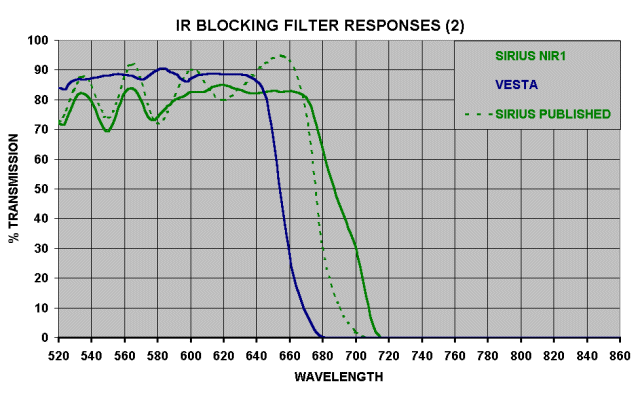
SPECTROSCOPY
IR BLOCK FILTER RESPONSE TESTS
(Updated 12th Jan 03 - Sirius NIR v Vesta, 25th Feb 03 Baader UV-IR CUT published curve added)
In the search for the best and most cost effective IR Blocking filter for deep sky LRGB imaging, I have used my
bench spectrometer set up to compare the response of various IR block filters in my possession with two cost effective commercial alternatives.The IRB filters from a Vesta 675 Pro webcam, a late 1980s JVC camcorder and a greyscale connectix QuickCam were measured on my rig.
Data for Steve Mogg's F-UWIR filter was obtained here
http://webcaddy.com.au/astro/ir_block_test.htm
Data for the Baader IRB filter (KG5) was obtained here
and for the Baader UV IR CUT from here
SPECTRUM IMAGES


Conclusions
The camcorder and Quick Cam filters cut off a significant amount of visible red light, including the H alpha line at 656 nm, which is important for emission nebula imaging.
The Mogg filter also has a reduced response in the red region and has only 35% transmission of H alpha
The Baader KG5 filter includes all the visible red with over 70% transmission of H alpha
The Baader UV IR CUT filter has a well defined cut off and includes all the visible red including the H alpha line and has the best response of the filters compared here (published curve added 25th Feb 03)
The Vesta filter includes most of the visible red with a sharp cut off close to the H alpha wavelength. Unfortunately, from the accuracy of this spectroscope set up, it is not possible to tell which side of H alpha the cut off lies.
Potentially, the Vesta could be the best IRB filter, depending on which side of H alpha the cut off lies.
(but see Baader UV IR CUT added 25th Feb 03)STOP PRESS 12th Jan 03 !
I have borrowed a Sirius NIR1 filter which has a well defined published response
http://www.siriusoptics.com/nirfltr.htm
This has allowed me to check the calibration of the spectrometer. The comparison with the Vesta filter is shown below
SPECTRUM IMAGES


This confirms that the Vesta filter cuts off before the Sirius filter and the cut off indeed lies at the H alpha (656nm) wavelength. Practical imaging tests are going to be needed to determine how much H alpha the Vesta filter passes in practise.
Update 16th Jan 03
Initial results on M42 with an SLR lens look promising with good nebulosity and tight stars